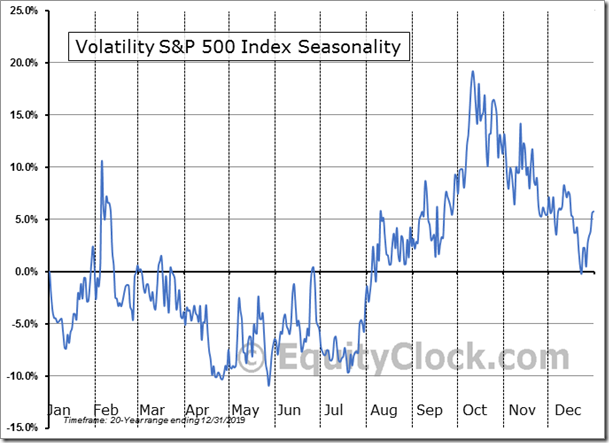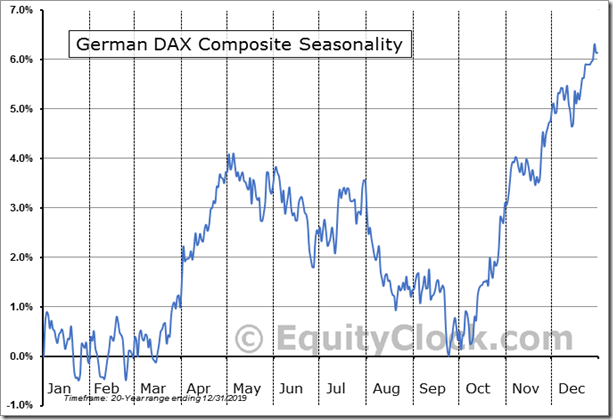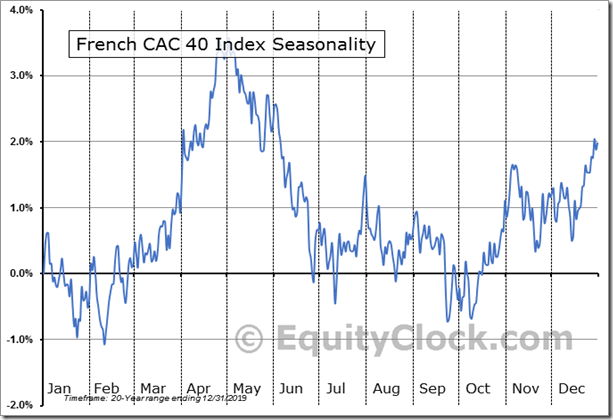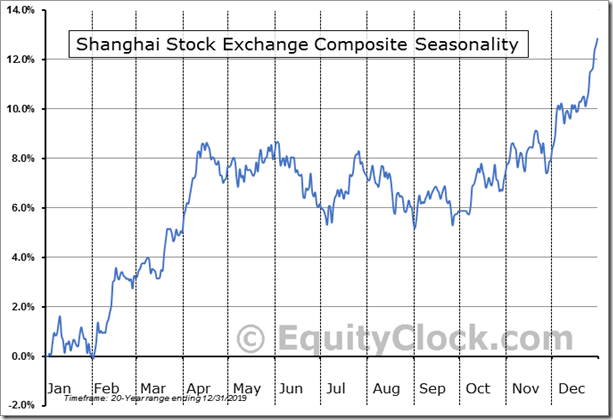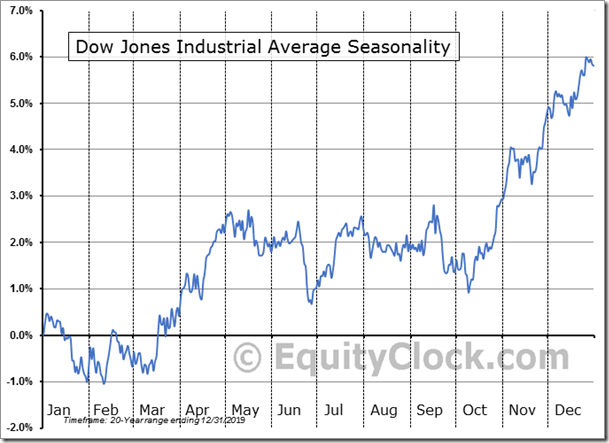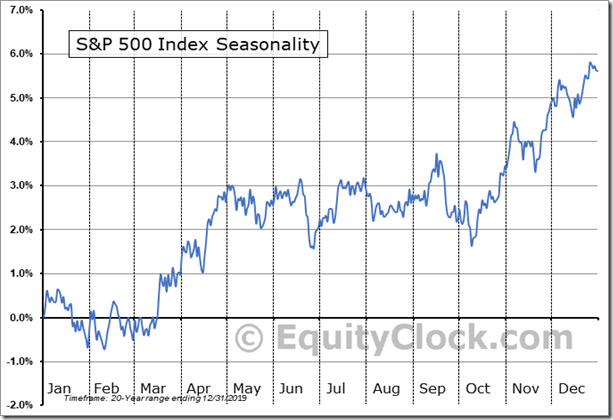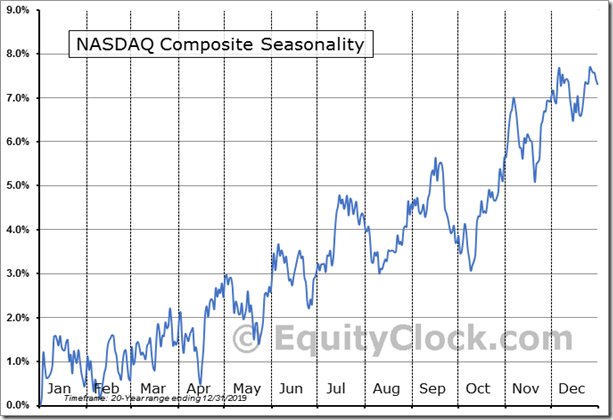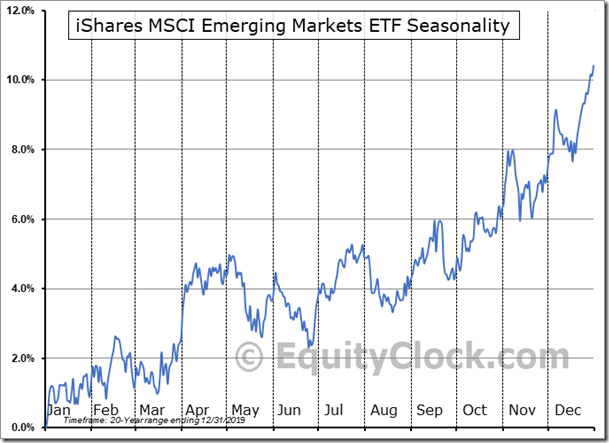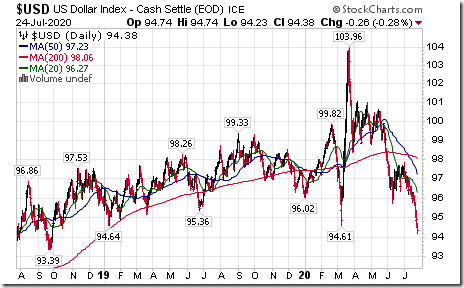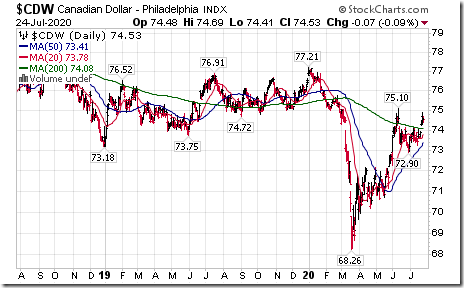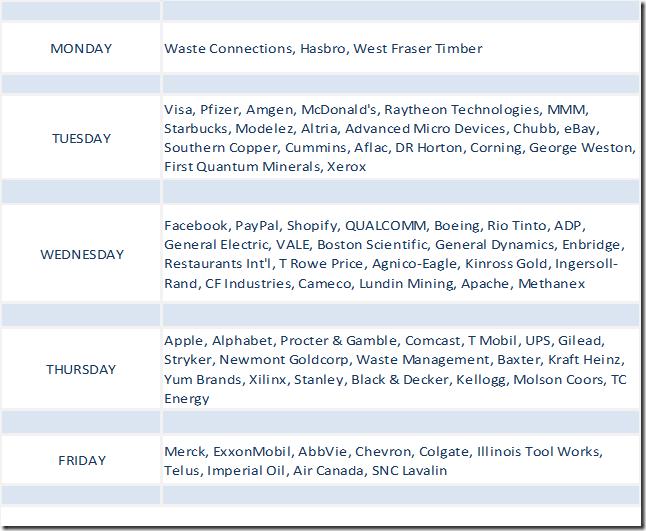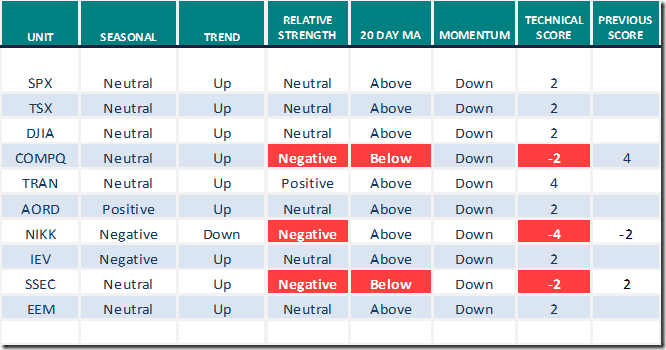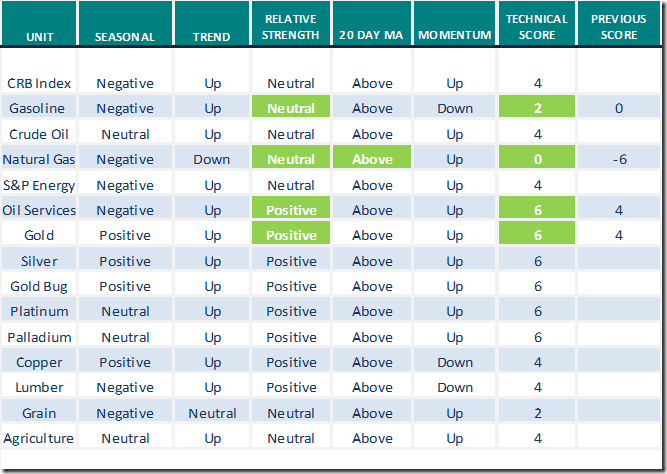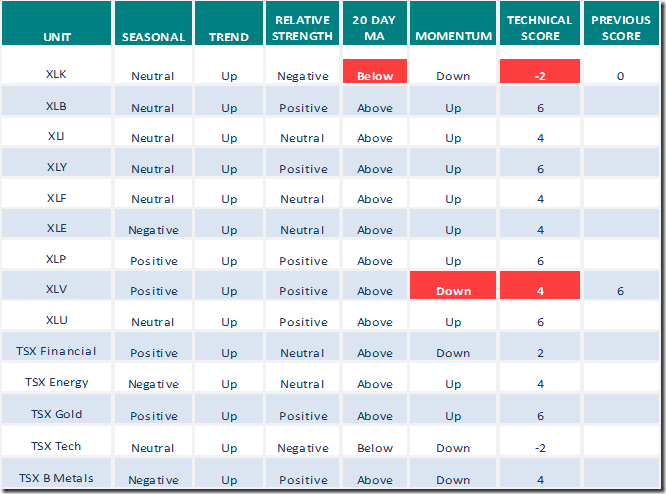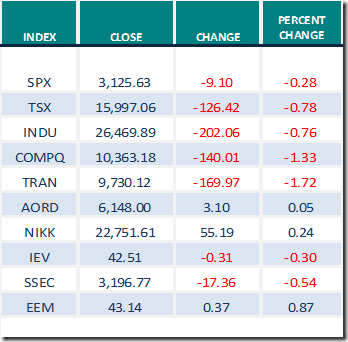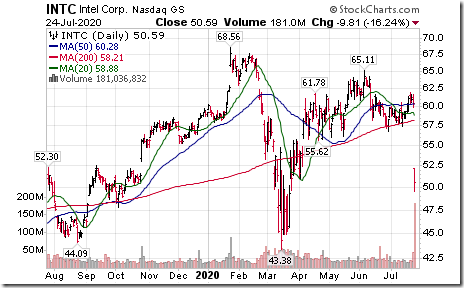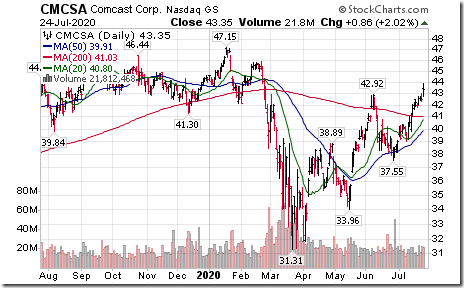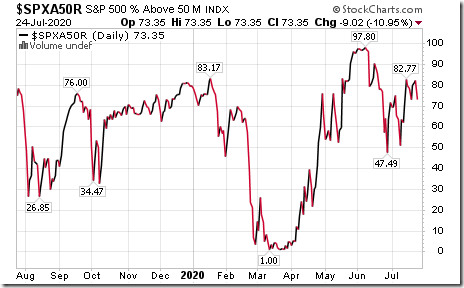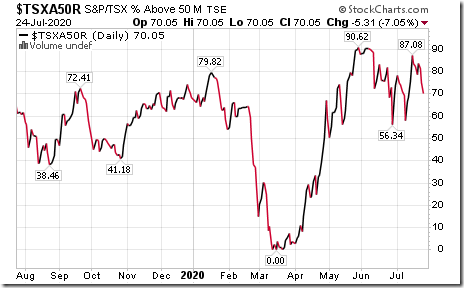by Don Vialoux, EquityClock.com
The Bottom Line
Most equity indices around the world moved slightly lower last week. Major influences remained concern about a second wave of the coronavirus (negative) and possibility of approval of a vaccine by early November (positive). Technical indicators for North American equity markets remained intermediate overbought and past their peak. The VIX Index remained elevated and typically moves higher from now to early October. Seasonal influences for most equity markets around the world tend to be negative between now and early October. Look for volatile, choppy markets between now and October.
Observations
The VIX Index (better known as the Fear Index) remained elevated last week.
Many equity indices reached an intermediate peak on schedule this year near mid-July (+ or – two weeks). The weakest period during the year for most equity indices is from mid-July to early October (+ or – two weeks).
Weakness in the U.S. Dollar continued. Last week, the U.S. Dollar Index moved below 94.61 to a 20 month low extending an intermediate downtrend.
Conversely, the Euro and the Canadian Dollar moved higher. The Euro reaching a 15 month high.
Late last week, Greg Schnell released an interesting report on currencies and their impact on equity prices. The report is entitled, “The Buck Stops Here”. Following is a link:
https://stockcharts.com/articles/canada/2020/07/the-buck-stops-here-645.html
U.S. Dollar weakness prompted higher commodity prices. The CRB Index has gained more than 40% from its low set in mid-April.
A weak U.S. Dollar prompted strength in gold, gold equities and related ETFs. All recently entered their best annual period of seasonal strength from the third week in July to late September.
Medium term technical indicators for U.S. equity markets (e.g. Percent of S&P 500 stocks trading above their 50 day moving average) remained overbought last week and have rolled over. See Barometer chart at the end of this report.
Medium term technical indicators for Canadian equity markets also remained overbought last week. See Barometer chart at the end of this report.
Most short term short term momentum indicators for U.S. markets and sectors (20 day moving averages, short term momentum indicators) changed from up to down late last week.
Short term momentum indicators for Canadian markets/sectors also moved from up to down last week.
Year-over-year 2020 consensus earnings estimates for S&P 500 companies moved slightly higher from depressed levels last week. Twenty six percent of companies have reported second quarter results to date with 81% reporting higher than consensus earnings. According to FactSet, second quarter 2020 earnings are expected to fall 42.4% (versus a drop of 44.0% last week) and revenues are expected to drop 10.1% (versus 10.5% last week). Third quarter earnings are expected to fall 24.0% (versus 24.4% last week) and revenues are expected to decrease 5.1% (versus 5.4% last week). Fourth quarter earnings are expected to drop 12.3% (versus 12.4% last week) and revenues are expected to decline 1.7% (versus 1.8% last week). Earnings for all of 2020 are expected to decrease 20.7% (versus 21.1% last week) and revenues are expected to decline 3.6% (versus 2.8% last week).
Summer rally this year? The summer rally happened on schedule this year despite release of “jaw dropping” declines in second quarter earnings results by North America’s largest companies. North American equity markets have a seasonal “sweet spot” from the last week in June to the third week in July. This year, gains during the period were the highest in over a decade: the TSX Composite Index gained 6.5%, the S&P 500 Index advanced 8.8% and the NASDAQ 100 Index jumped 10.4%.
Consensus estimates for earnings and revenues by S&P 500 companies turn positive on a year-over-year basis in the first quarter of 2021. According to FactSet, earnings in the first quarter of 2021are expected to increase 12.7% (versus 12.1% last week) and revenues are expected to increase 3.0% (versus 2.8% last week). Earnings for all of 2021 are expected to increase 28.1% (versus 28.0% last week) and revenues are expected to increase 8.3% (versus 8.4% last week).
Economic News This Week
June Durable Goods Orders to be released at 8:30 AM EDT on Monday are expected to increase 6.5% versus a gain of 15.7% in May. Excluding Transportation Orders, June Durable Goods Orders are expected to increase 3.5% versus a gain of 3.7% in May.
FOMC statement on interest rates is released at 2:00 PM EDT on Wednesday. Press conference is offered at 2:30 PM EDT. Consensus is that the Fed Fund Rate will remain at 0.25%.
First estimate of annualized second quarter U.S. GDP to be released at 8:30 AM EDT on Thursday is expected to be -35.0% versus -5.0% in the first quarter.
June Personal Income to be released at 8:30 AM EDT on Friday is expected to drop 0.2% versus a decline of 4.2% in May. June Personal Spending is expected to increase 5.0% versus an increase of 8.2% in May.
May Canadian GDP to be released at 8:30 AM EDT on Friday is expected to increase 3.1% % versus a decline of 11.6% in April.
July Chicago PMI to be released at 9:45 AM EDT on Friday is expected to improve to 43.0 from 36.6 in June.
July Michigan Consumer Confidence to be released at 10:00 AM EDT on Friday is expected to slip to 72.8 from 73.2 in June.
Selected Earnings News This Week
Another 192 S&P 500 companies (including 12 Dow Jones Industrial Average companies) are scheduled to report quarterly results this week. Major Canadian companies start to appear with 10 TSX 60 companies scheduled to report.
Trader’s Corner
Equity Indices and related ETFs
Daily Seasonal/Technical Equity Trends for July 24th 2020
Green: Increase from previous day
Red: Decrease from previous day
Commodities
Seasonal/Technical Commodities Trends for July 24th 2020
Green: Increase from previous day
Red: Decrease from previous day
Sectors
Daily Seasonal/Technical Sector Trends for July 23rd 2020
Green: Increase from previous day
Red: Decrease from previous day
Technical Scores
Calculated as follows:
Intermediate Uptrend based on at least 20 trading days: Score 2
(Higher highs and higher lows)
Intermediate Neutral trend: Score 0
(Not up or down)
Intermediate Downtrend: Score -2
(Lower highs and lower lows)
Outperformance relative to the S&P 500 Index: Score: 2
Neutral Performance relative to the S&P 500 Index: 0
Underperformance relative to the S&P 500 Index: Score –2
Above 20 day moving average: Score 1
At 20 day moving average: Score: 0
Below 20 day moving average: –1
Up trending momentum indicators (Daily Stochastics, RSI and MACD): 1
Mixed momentum indicators: 0
Down trending momentum indicators: –1
Technical scores range from -6 to +6. Technical buy signals based on the above guidelines start when a security advances to at least 0.0, but preferably 2.0 or higher. Technical sell/short signals start when a security descends to 0, but preferably -2.0 or lower.
Long positions require maintaining a technical score of -2.0 or higher. Conversely, a short position requires maintaining a technical score of +2.0 or lower
Changes Last Week
Technical Notes for Friday
Intel (INTC), a Dow Jones Industrial stock moved below $56.76 setting an intermediate downtrend. The stock responded to lower than consensus third quarter guidance.
Altria (MO), an S&P 100 stock moved above $42.22 extending an intermediate uptrend.
Comcast (CMCSA), an S&P 100 stock moved above $42.92 extending an intermediate uptrend.
S&P 500 Momentum Barometer
The Barometer dropped last week from 78.51 to 73.25 with most of the drop occurring on Friday. The Barometer remains intermediate overbought, but has passed an intermediate peak and shows short term signs of moving lower.
TSX Momentum Barometer
The Barometer dropped last week from 82.30 to 70.05. The Barometer remains intermediate overbought, but has passed an intermediate peak and shows short term signs of moving lower.
Disclaimer: Seasonality and technical ratings offered in this report and at
www.equityclock.com are for information only. They should not be considered as advice to purchase or to sell mentioned securities. Data offered in this report is believed to be accurate, but is not guaranteed
This post was originally publised at Vialoux's Tech Talk.





